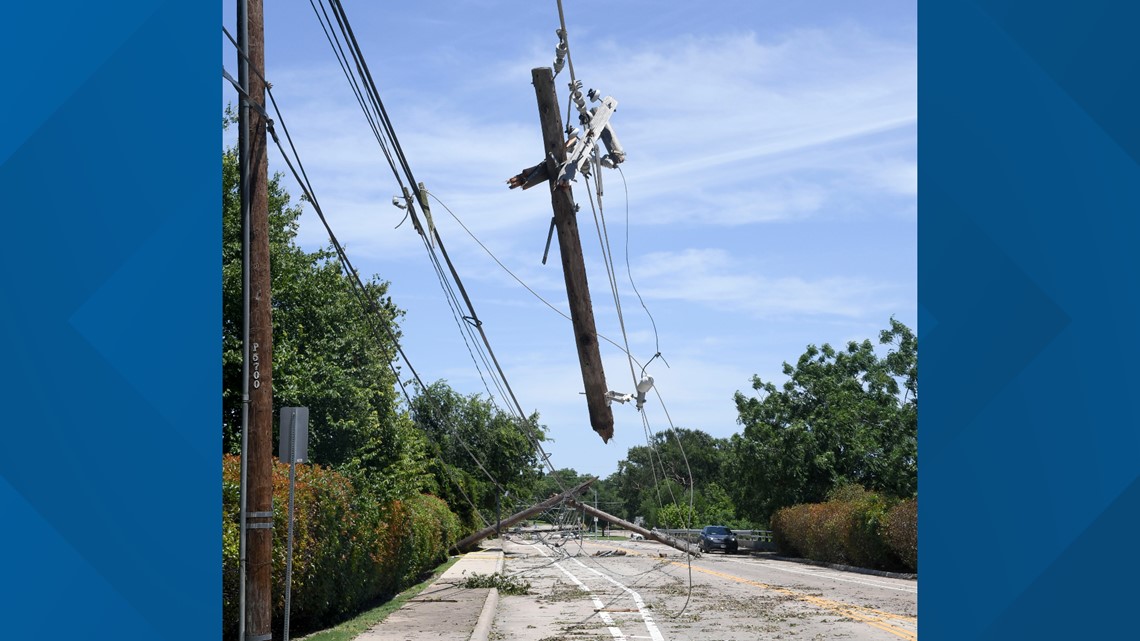This story has been updated with details about the shifts crews worked to restore power.
Restoring power to hundreds of thousands of area residents isn’t as easy as flipping a switch: It requires planning and practice long before a storm strikes, plus a decisive real-time response.
The storms that struck Dallas with 70 mph winds and left more than 350,000 people in early June without power were some of the worst conditions Oncor Electric Delivery has faced in its existence.
On June 9, a quiet Sunday afternoon was disrupted by driving rain, hail and straight-line winds that barreled through the city. They wiped out power lines, trees and left a path of destruction across the city. The storm even knocked over a crane near downtown onto an apartment building, killing a woman inside.
Oncor officials said it was in the top 10 worst weather they’ve had to handle, which prompted them to request assistance utility crews from 11 states.


Overall, it took Oncor about five days to restore power across the city with the help of its out-of-state partners, prioritizing critical care facilities, such as fire departments and hospitals. After that, the company then worked to repair the damaged lines that provided power to the most amount of people in the city.
Naturally, tempers flare when customers lose power, even for a few hours. Social media was ablaze with vitriol for Oncor’s inability to flip a switch and turn the power immediately back on — and as hours turned to a day and then multiple days, some customers continued to vent their frustration via Twitter, Facebook and Instagram posts. The company responded where it could, reminding residents that this was an extraordinary situation that required additional patience.
As a matter of routine, Oncor maintains contracts with meteorologists, along with keeping its in-house meteorologists, and sends out weather bulletins to its staff each Friday. The company realized there could be severe storms on June 8 or June 9 and stayed alert.
When executives realized the extent of the damage from the storm system, they activated the emergency center, which called in most of the employees and sent notices to external teams. The first step to fixing the problems? Actually assessing all of the damage.
Oncor provides power to 3.6 million businesses and homes to more than 400 Texas cities, making it the largest electricity distributor in the state. The day after the storms plowed through Dallas, a spokesperson said there were about 5,700 Oncor employees, along with the teams from external power companies and utility firms working 16-hour shifts — 16 hours on, then 8 hours of rest — to restore power. Within about 24 hours, the company had restored nearly 70 percent of the power that had been lost.
Though isolated pockets of several areas didn’t completely lose power, such as the Park Cities, Mockingbird Station and Preston Center, among others, the damage was widespread. Even in areas where power wasn’t affected, tree limbs blocked major thoroughfares, for example.
Keith Hull, Vice President of Distribution Operations at Oncor, discussed how Oncor prepares and handles mass power outages like those experienced by Dallas in June:
What does planning look like for something like this?
Oncor has worked hard to develop and maintain efficient emergency management and preparedness strategies for weather events, including conducting drills throughout the year and coordinating closely with statewide partners such as ERCOT. We also maintain an emergency-stock level of materials, supplies and equipment, as well as emergency response agreements with suppliers to ensure there are no shortages when devastating storms impact the company’s service area. Furthermore, Oncor meteorologists and personnel are consistently monitoring the weather and its potential impact to our customers. In advance of potentially severe weather, we pre-position crew members and equipment so they can immediately begin the process of restoring power as soon as it is safe for them to do so.
Oncor cooperates with private and public utilities throughout Texas, and across the country, through mutual assistance partnerships. These partnerships provide Oncor the ability to quickly access and deploy personnel and resources across long distances.


Oncor works year-round to prepare our equipment for periods of inclement weather. This includes inspecting and pruning trees, as well as managing other areas of vegetation, regularly working to expand and upgrade transmission and distribution lines, and making major investments in technologies that help limit and shorten power outages.
Are there alternative plans for different types of weather-related incidents?
Yes. Every weather-related incident comes with its own unique response efforts and potential operational challenges. However, Oncor’s plan of action is always based on the same priorities: ensuring the safety of our customers and crews and restoring power as quickly and safely as possible.
For example, while the severe storms of early June brought damage to wide swaths of our service territory on scale with a tropical storm, a tornado may only bring severe impacts to an isolated community. Similarly, the safety hazards and response efforts of a summer storm vary greatly from that of a winter ice storm.
Where does this rank in terms of the scope of Oncor’s coverage area among number of affected parties?
In terms of the scale of concentrated outages and widespread damage, this storm represents one of the top 10 worst storms in the history of Oncor. As the fastest-growing metropolitan area in the country, and one of the most populated areas in Texas, storms of this magnitude can be especially challenging for Dallas-Fort Worth. More than 350,000 Oncor customers, primarily across Dallas-Fort Worth, were without power at the height of the storm. While extensive damage to infrastructure, vegetation, transportation networks, and impacts to street lights created accessibility obstacles and safety hazards, Oncor and mutual assistance crews worked around-the-clock to restore power to hundreds of thousands of customers as quickly and safely as possible.
We had many sightings of out-of-state workers and vehicles. What is the scope of out-of-city and out-of-state entities that were involved?
Mutual assistance crews from 11 different states, including Alabama, Arkansas, Florida, Georgia, Illinois, Kansas, Louisiana, Mississippi, Missouri, North Carolina and South Carolina deployed to the Dallas-Fort Worth area to support power restoration efforts. CenterPoint Energy, AEP Texas, Texas-New Mexico Power Co., Austin Energy and CPS Energy of San Antonio also responded.
Regardless of what city or state they were from, these mutual assistance crews worked long, strenuous hours, treated our customers as their own and supported our communities during a time of need. We greatly appreciate their support and remain committed to supporting them in return.
Oncor also repositioned crew members from other parts of the state to the Dallas-Fort Worth area. This included individuals from as far west as Midland, and as far south and east as Lufkin and Round Rock, all of whom worked around the clock in 16-hour shifts to help.
How does interoffice communication work between those entities?
Oncor personnel serve as liaisons between the Company and various utility partners across the state and nation. These relationships help ensure response efforts are expedient and efficient, regardless of where disaster strikes.
Communication is not only requesting assistance, but also ensuring that crews are welcomed with the resources they need to successfully support restoration efforts. Ahead of these crews’ arrival, Oncor personnel work to prepare staging areas, hotel and meal accommodations, field logistics, refueling locations, and equipment restocking supplies. This complex coordination of workforce and resources is often completed in a matter of hours and is practiced by Oncor personnel throughout the year to ensure the most efficient execution.
Mutual assistance crews who respond to our request for assistance are reimbursed for the actual cost of providing services.
Mutual assistance partnerships have existed across the electric utilities industry for many years, and show our unique, shared commitment to helping those in need. In recent years, Oncor has deployed our own equipment and crews to support restoration efforts after the devastation of Hurricane Harvey in Houston, Hurricane Michael in Florida, Hurricane Maria in Puerto Rico, and wildfires in California.
What does a timeline look like for deployment of resources?
As with every weather event, Oncor crews were on the road assessing damage and beginning the restoration process as soon as it was safe for them to do so. Initial assessments revealed downed power lines, heavily
damaged distribution equipment and poor road conditions from fallen trees and debris. Oncor meteorologists and personnel also monitored the arrival of these storms and documented golf ball-sized hail, intense cloud-to-ground lightning, strong rain and winds in excess of 70 mph. Nearby mutual assistance crews were called in the evening of these storms and the remainder of our mutual assistance partners from 11 different states arrived on June 11. We also opened Oncor’s System Emergency Center, and staffed it with Oncor leadership, within hours of the storm’s arrival.
Allen Nye, Oncor’s CEO, was informed of the potential for severe weather well ahead of the arrival of these storms. He remained in constant contact with Operations personnel monitoring the severity and impact of the storms on June 9 and continued to oversee restoration efforts throughout the week.
When was it apparent that there were widespread outages?
Very shortly after the storm’s arrival. While it has been many years since North Texas experienced a weather event of this magnitude, Oncor has experienced severe storms before. As we received reports of 70 mph winds, golf ball-sized hail and other severe impacts, we began to anticipate the possibility of wide-spread outages.
Oncor’s Advanced Meters are also able to report electric data directly to Oncor, including quickly notifying us of potential outages.
When the worst of the storm had passed, as soon as it was safe for crews to be on the road, we began damage assessments. Using both specially designed drones, and Oncor operations personnel, these assessments quickly revealed the full extent of damage, and the likelihood that repairs would include complex, and time-consuming reconstruction of distribution equipment, including the replacement of thousands of utility poles and transformers.
More on WFAA:
- The process begins: Plan released for Elan City Lights residents to recover belongings
- City of Dallas asks for patience as storm debris waits nearly a month for removal
- Crane company claims high winds cause of collapse that killed woman
- 'She's just so beautiful': Fiancé of woman killed in crane collapse describes that terrible Sunday



